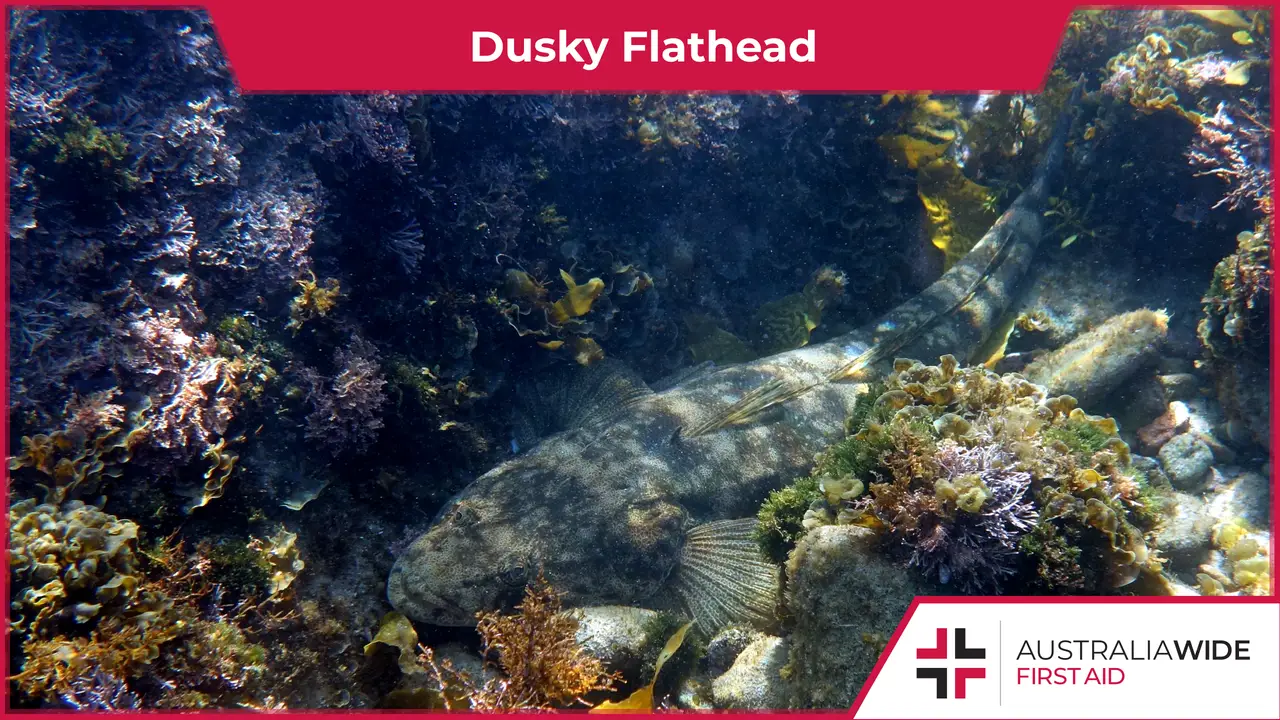First Aid for Dusky Flathead Sting


Dusky Flathead are a popular catch while throwing a fishing line out during the holidays. They can make a tasty meal, too.
Dusky Flathead are the largest of Australia’s flathead species. Commonly caught along the Australian east coast, they have venomous spines along the centre of their body. A sting from a Dusky Flathead can inflict excruciating pain and the wound may be prone to infection if not treated immediately.
Continue reading for more information about the Dusky Flathead, signs of a sting, and basic first aid treatment.
If you are interested in learning more about first aid for fish and other marine stings, enrol in one of our first aid courses:
Head to our website to find a course near you - we have locations all across Australia.
As the largest of the Australian flathead species, the Dusky Flathead (platycephalus fuscus) can reach just over 1 metre in length with a weight of at least 15 kg. The Dusky Flathead size makes it a good catch for recreational fishing as well as a tasty main dish.
Flathead are long “flat” fish with a body that elongates towards their large head from the tail.
The Dusky Flathead is dark brown to sandy and covered in spots or blotches that contrast its main colour. It is distinguished by the rows of soft brown spots on the pectoral (chest or side) fins and on the top of the caudal (tail or back) fin.
The Dusky Flathead can be differentiated from the Southern blue spotted flathead by the presence of a single dark (blueish grey) spot on the top half of it’s caudal fin. However, this spot may be absent in some mature fish.
The Dusky Flathead has a row of sharp spines that are both painful and venomous. These spines run along the centre of its body beside the gills on both the dorsal (top) and ventral (bottom) sides.
The Dusky Flathead, otherwise known as the Black Flathead, is common to the east coast of Australia and lives in sheltered rocky reefs. It frequently swims and feeds in sand, mud, gravel, and sea grass. Anglers often catch Dusky Flathead at depths of less than 25 metres.
The Dusky Flathead can be caught in coastal bays and estuaries up to the tidal limit, including the Gippsland Lakes in Victoria.
The Dusky Flathead enjoys feeding on other fish, crustaceans and sand-dwelling squid. Like other Flatheads, it is a predator and enjoys hunting.
These flathead are popular with recreational fishing: you can catch one using either lures or bait, from land-based fishing locations, such as piers and rock walls, and at any point during the tide.
Generally speaking, female Dusty Flatheads reach maturity at around 55cm, while males reach it at 22cm. In order to keep populations sustainable, if fishing, check with local regulations about the take home size limit.
Even if fishing for a Dusky Flathead is not about catching your next meal, make sure you practice fishing techniques that both look after your health, the environment, and your catch:
Head to the Fishcare Victoria for more techniques on hook removal for the Dusky Flathead.
While the Dusky Flathead is a harmless fish, interaction with the venomous spines can be painful and cause infection if not treated promptly. Signs of a Dusky Flathead sting can include:
If you believe you have been stung by a Dusky Flathead, treat it is an emergency and seek immediate medical help:
If you handle fish without protective gloves, take care to wash your hands frequently to avoid skin problems.
The Dusky Flathead is a common fish found in waters on the Australian east coast. It is popular with anglers and fishmen, as it can be both fun to catch and make a tasty meal.
Caution must be taken with the venomous spines that run along the body of the Dusky Flathead. These spines can cause a painful wound and infection.
If you have been stung by a Dusky Flathead, prompt first aid and emergency medical care are necessary.
If you are interested in learning more about first aid for fish or other marine stings, enrol in one of our first aid courses:
Head to our website to find a course near you - we have locations all across Australia.

October 13, 2023
Choking occurs when an object or a piece of food becomes lodged in the throat, blocking the airway. The adult or child will have difficulty breathing, and may lose consciousness. Quick and effective action is essential to prevent severe consequences and death.

September 22, 2023
Knowing how to provide first aid for fluid draining from an ear is crucial to alleviate discomfort and potentially prevent complications.

July 31, 2023
This article covers treatment/first aid for nose bleeds, and also covers all of the common misconceptions and myths about treating a bleeding nose.